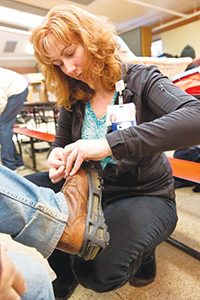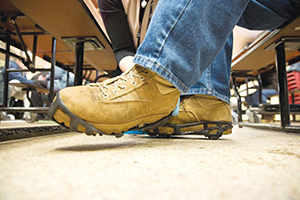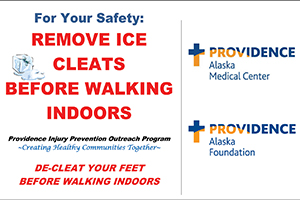A bad slip on the ice can cause 'life-changing' injuries
By JULIE MINDA

Sara Penisten Turcic, a nurse and injury prevention outreach coordinator for Providence Health & Services Alaska, fits a client with ice cleats at Bean's Café, an Anchorage facility that serves people who are homeless.
The average high temperature is below freezing for four months of the year in Anchorage, Alaska, and freezing temperatures are a possibility at any time of the year, according to data from the Weather Channel. Icy streets and sidewalks are part of the package in the city of nearly 300,000, and that ice presents a particular risk for the approximately 1,000 people in Anchorage who are homeless — as well as for other vulnerable populations.
That is why Providence Health & Services Alaska has been donating hundreds of ice cleats every year since 2013 to people who are homeless as well as to other people in need. The cleats, which strap to the bottom of shoes or boots, have spikes that provide traction on slick ice. According to information from Sara Penisten Turcic, injury prevention outreach coordinator for Providence Alaska, the cleats can help people to avoid falls that can lead to serious injury.
Through the cleat distributions, she said, "We hope to prevent these falls, which can be life-changing if they result in serious injuries. Especially for people who are on the margins, and don't have adequate medical insurance," falls can be ruinous.
Brainstorm
The cleat donation program found its genesis in 2013 efforts by Penisten Turcic and colleagues to transition Anchorage's Providence Alaska Medical Center, which is the flagship of Providence Alaska, to a Level II trauma center. To achieve that designation, the hospital had to demonstrate increased attention to injury prevention across multiple generations of community members. Data analysis conducted in relation to that work confirmed that falls were the top cause of traumatic injury for patients, and the data revealed that falls increase in winter.

The ice cleats attach to the bottom of shoes to increase traction and reduce the risk of falls.
Penisten Turcic recalled: "We wondered, 'What in the world could we do to impact fall numbers?'" In brainstorming answers, she and her colleagues came up with the idea of distributing ice cleats to people at high risk of falls due to their living situations.
The Providence Alaska Foundation agreed to purchase the cleats, and the inaugural distribution in the winter of 2013 and 2014 at Bean's Café provided hundreds of cleats to homeless people. Bean's Café is a homeless services agency in Anchorage.
Since the cleats are reusable, Providence Alaska has been aiming to reach new recipients each year by expanding the groups it works with for the distributions. This year, Penisten Turcic said, Providence Alaska has distributed cleats through numerous organizations, including:
- Twenty faith community congregations, through their faith community nurses.
- Catholic Social Services' Refugee Assistance & Immigration Services unit.
- Catholic Social Services' Clare House, an emergency shelter for women and children.
- The Anchorage Literacy Project.
- The Veterans Affairs' Domiciliary program.
- The Abused Women's Aid in Crisis domestic violence shelter.
- The Providence Horizon House eldercare residence, part of Providence Alaska.
Penisten Turcic estimates the foundation, which funds most of the cleat donations, spends around $10,000 per year to buy about 600 pair of cleats for a per-unit cost of less than $20.
Dangerous streets
In most cases, Penisten Turcic trains volunteers and staff at the agencies on how to fit clients with the right-sized cleats. Sometimes, she'll do the fittings herself. She also instructs the volunteers and staff on how to explain to the clients how to safely walk with cleats.

Providence Alaska Medical Center displays this sign in its facilities during inclement weather.
This is the first year the Abused Women's Aid in Crisis shelter has received cleats, and shelter case manager Fabienne Smith said the cleats have had "an amazing impact" with dozens of vulnerable women receiving them. She explained, "Our town is so spread out, and so when these women need to use our bus system to get to different agencies for help, they often need to walk to the bus stops. It can be quite a journey in winter."
Walking on ice while pregnant or while carrying a baby or child increases the fall risks for all involved; the cleats provide for increased traction on ice-slick surfaces. Smith said that for women who have been abused, the cleats provide an extra measure of safety in the event they feel threatened and need to flee. "They're in an already-scary situation. This gives extra comfort, and they can feel empowered that they can get where they need to go safely."
Penisten Turcic noted that new members of Anchorage's immigrant community may be unaccustomed to cold weather and to walking on ice, and so the cleats and the information on safe walking is very helpful to them.
Penisten Turcic said the program has been very well received and well appreciated. "Ice cleats are a simple way to build healthy communities together," she said.